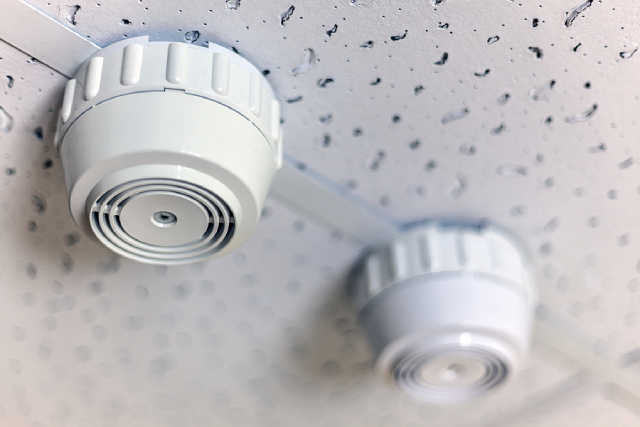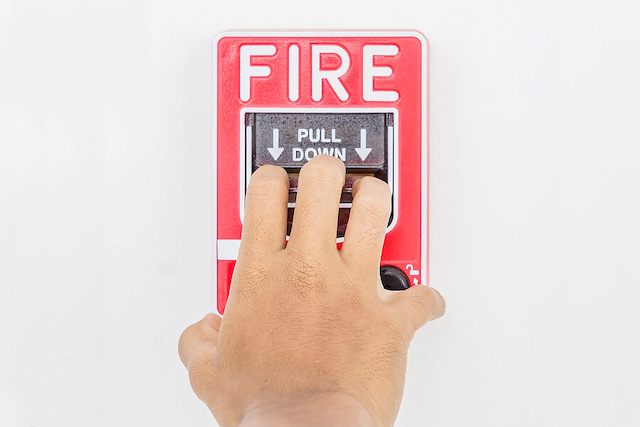Safeguarding building occupants against the threat of fire and smoke inhalation is the top priority for property owners and fire safety managers. While there is no denying the importance of investing in the right fire suppression system that best fits a given structure and its facilities, it is also critical to take the time to understand the core devices that trigger them in the first place — smoke detectors. Below, we take a look at the main types of smoke detectors, how they work, and the ideal environments to place them in.
Optical Beam or Photoelectric Smoke Detectors
Optical beam or photoelectric smoke detectors identify the presence of fire via the principle of light obscuration. The device consists of a reflector and a beam transmitter/receiver unit and gets triggered if smoke disrupts the beam from the transmitted light to a certain extent. Optical beam smoke detectors are commonly used in large, open areas like warehouses, wherein they can quickly pick up on smouldering and smoky fires that can fill a space with dangerous gases before ever erupting into a full-blown fire. Examples of the causes of such fires include upholstery catching fire or overheating PVC wiring.
Aspirating Smoke Detectors (ASD)
Aspirating smoke detection systems are among the highly sensitive smoke detectors available today, making them the ideal choice for environments such as data centres, warehouses, and other places with high ceilings, wherein an early warning can make all the difference. ASDs work through sampling pipes that draw in air from a space using fans. This air is sent to precise detectors that can easily pick up smoke particles. The main benefit of ASDs is their wide detection capability that can detect everything from cool smoke to smouldering fires. This comes at the cost of higher maintenance and installation costs compared to other systems.
Ionisation Alarms
Ionization alarms are among the most common and affordable smoke detectors available today. These devices contain a tiny radioactive material flanked between two electrically charged plates that ionise the air and cause a current to flow between them. The smoke disrupts this flow of ions, creating an electrical imbalance that reduces the current flow and ultimately triggers the alarm.
Ionisation detectors are a suitable choice for most workplace environments but not ideal for use in kitchen areas due to false alarms. Since they respond well to fast-flaming fires, buildings that deal with or stock flammable paints and liquids often prefer these systems.
Heat Alarms
Technically, heat alarms are not smoke detectors since they are triggered by heat, as the name implies. These devices have a thermistor designed to detect unexpected spikes in temperature and activate the alarm once a certain threshold is reached, which is generally 58°C. Because of the way they work, heat alarms are more suited for use in kitchens and restaurants since they will not trigger false alarms due to cooking smoke or steam. Auto repair shops and garages also prefer heat alarms, as exhaust fumes and dust can trigger conventional smoke detectors.
Multi-Sensor Alarms
Multi-sensor alarms are the best choice for property owners looking to cover all their bases. These devices are essentially heat alarms and optical beam smoke detectors combined into one, providing functionality to detect and monitor both heat and smoke from fires. This allows for 24/7 response to all kinds of fire, be it a blazing fire at high temperatures or a smouldering flame.
Conclusion
Smoke detectors come in different types and functionalities that make them more suited to certain environments than others. As such, it is important to delve further into their pros and cons and evaluate which type or combination of types is the right fit for your establishment.
For more in-depth learning about fire suppression systems and their core components, like smoke detectors, consider enrolling in a fire safety course in Singapore today! TenLearn’s online learning platform is the best place for Fire Safety Managers looking for SCDF-approved courses that cover topics ranging from common fire safety non-compliances to automatic extinguishing systems.
Keep your skills sharp and updated while earning CPD points with an FSM course in Singapore today -- all at your convenience.


Write a public review